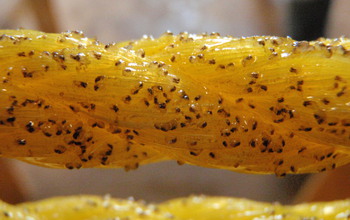 Blue mussel larvae settled on a rope. |
September 25, 2014
Blue mussels, Mytilus edulis, live on northern Atlantic shores in the area between high and low tides.
"Mussels are one of the most significant filter-feeders in the marine environment," said Brian Beal, a marine ecologist at the University of Maine at Machias. "They are responsible not only for efficiently producing high-quality protein but for cleaning the waters around them through their feeding activities."
Because many creatures--especially humans--enjoy eating blue mussels, farmers grow mussels using aquaculture, or aquatic farming. More than 650,000 pounds of blue mussels were cultured and harvested in Maine in 2012, according to the state's Department of Marine Resources.
Young mussels may be cultivated in the wild, or they may grow on ropes that are submerged in culture tanks, where they are protected from storms and predators. Once the mussels reach a certain size, they are moved into ocean pens to mature.
But practitioners often struggle in their efforts to increase the number, size and overall health of their mussels. Like many farmers, they turn to science and engineering to improve their harvest.
Beal, along with a team of National Science Foundation (NSF)-funded researchers at the University of Maine at Machias and theDowneast Institute, is investigating the growing conditions and practices that will reliably yield healthy and plentiful blue mussels.
"Our goal is to develop methods in the hatchery to create consistent quantities of seed-size mussel juveniles," Beal said. "At present, mussel farmers rely on wild settlement, which can be very spotty from year to year and from place to place." Maine's annual harvest of cultured blue mussels commonly varies by hundreds of thousands of pounds.
Young mussels go through several stages of development. After swimming for their first few weeks of life, mussel larvae adhere to an underwater surface such as a rope. They attach themselves using byssus threads, which are flexible strands of protein.
"A narrow range of seawater temperatures combined with relatively high salinities results in healthy, active juveniles," Beal said, "and different phytoplankton diets fed to the swimming larvae affect their ability to settle effectively onto substrates such as rope."
Beal's team plans to use what they learn about blue mussel development to optimize how many and how well larvae secure themselves to rope used in aquaculture. They are now conducting field studies to examine the effects of stocking densities on mussel growth and survival.
The researchers also are investigating exactly when to transition the young mussels into ocean pens, and where in the pens they grow best.
With better understanding of their cultivation, the researchers and their partner New DHC, an aquaculture company, hope to improve commercial prospects for sustainably grown blue mussels.
"A consistent seed supply also will allow aquaculturists to create business plans that project their annual production more realistically," Beal explained.
The collaboration is supported by the NSF Partnerships for Innovation program, which stimulates regional innovation based on science and engineering discoveries.
In speaking of Beal, NSF program director Sally Nerlove said, "His life's work is of tremendous potential importance to the economy and the ethos of region, and, at the same time, his accomplishments track the evolution of the NSF Partnerships for Innovation program."
No comments:
Post a Comment